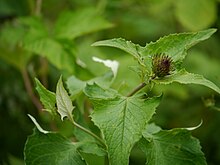
Myrrh is a gum-resin extracted from a number of small, thorny tree species of the genus Commiphora. Myrrh resin has been used throughout history as a perfume, incense and medicine. Myrrh mixed with posca or wine was common across ancient cultures, for general pleasure, and as an analgesic.

Coptis is a genus of between 10–15 species of flowering plants in the family Ranunculaceae, native to Asia and North America.

Saussurea is a genus of about 300 species of flowering plants in the thistle tribe within the daisy family, native to cool temperate and arctic regions of East Asia, Europe, and North America, with the highest diversity in alpine habitats in the Himalayas and East Asia. Common names include saw-wort and snow lotus, the latter used for a number of high altitude species in East Asia.

Withania somnifera, known commonly as ashwagandha, Indian ginseng, poison gooseberry, or winter cherry, is a plant in the Solanaceae or nightshade family. Several other species in the genus Withania are morphologically similar. Although thought to be useful as a medicinal herb in Ayurveda and sold in many countries as a dietary supplement, there is insufficient scientific evidence that it is safe or effective for treating any disease. Because of its lack of demonstrated efficacy and possible side-effects, it is currently not recommended for any condition.
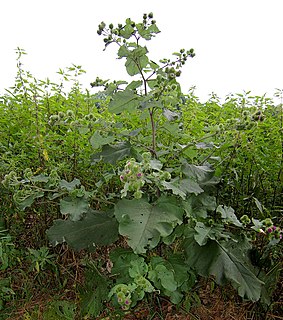
Arctium lappa, commonly called greater burdock, gobō (牛蒡/ゴボウ), edible burdock, lappa, beggar's buttons, thorny burr, or happy major is a Eurasian species of plants in the Aster family, cultivated in gardens for its root used as a vegetable. It has become an invasive weed of high-nitrogen soils in North America, Australia, and other regions.

Hemidesmus indicus, Indian sarsaparilla is a species of plant that is found in South Asia. It is a slender, laticiferous, twining, sometimes prostrate or semi-erect shrub. Roots are woody and aromatic. The stem is numerous, slender, terete, thickened at the nodes. The leaves are opposite, short-petioled, very variable, elliptic-oblong to linear-lanceolate. The flowers are greenish outside, purplish inside, crowded in sub-sessile axillary cymes. It occurs over the greater part of India, from the upper Gangetic plain eastwards to Assam and in some places in central, western and South India.

Asparagus racemosus is a species of asparagus common throughout India and the Himalayas. and northern Australia. It grows 1–2 m tall and prefers to take root in gravelly, rocky soils high up in piedmont plains, at 1,300–1,400 m (4,300–4,600 ft) elevation. It was botanically described in 1799. Because of its multiple uses, the demand for Asparagus racemosus is constantly on the rise. Due to destructive harvesting, combined with habitat destruction, and deforestation, the plant is now considered "endangered" in its natural habitat.

Commiphora wightii, with common names Indian bdellium-tree, gugal, guggul, gugul, or Mukul myrrh tree, is a flowering plant in the family Burseraceae, which produces a fragrant resin called gugal, guggul or gugul, that is used in incense and vedic medicine. The guggul plant may be found from northern Africa to central Asia, but is most common in northern India. It prefers arid and semi-arid climates and is tolerant of poor soil.

Andrographis paniculata, commonly known as creat or green chiretta, is an annual herbaceous plant in the family Acanthaceae, native to India and Sri Lanka.
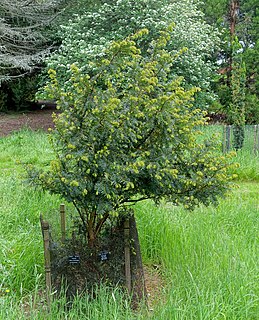
Taxus wallichiana, the Himalayan yew, is a species of yew, native to the Himalaya and parts of south-east Asia. The species has a variety of uses in traditional medicine. It is currently classified as endangered by the IUCN.

Prunella vulgaris is a herbaceous plant in the genus Prunella.

Rubia cordifolia, often known as common madder or Indian madder, is a species of flowering plant in the coffee family, Rubiaceae. It has been cultivated for a red pigment derived from roots.

Saussurea obvallata is a species of flowering plant in the Asteraceae. It is native to the Himalayas, Himachal Pradesh and Uttarakhand, India, Mongolia, northern Burma and southwest China. In the Himalayas, it is found at an altitude of around 4500 m. It is the state flower of Uttarakhand. Saussurea obvallata is a perennial growing to 0.3 m (1 ft). The flowers are hermaphrodite and are pollinated by insects. Flowers bloom in mid-monsoon (July–August) amongst the rocks and grasses of the hillside at an altitudinal range of 3000–4800 m. Flower heads are purple, hidden from view in layers of yellowish-green papery bracts, which provide protection from the cold mountain environment. The flowers can be seen till mid-October, after which the above-ground portions of the plant die back, becoming visible again in April. Local names of this flower are Brahma Kamal, Kon, Kapfu and vansembruu.

Boerhaavia diffusa is a species of flowering plant in the four o'clock family which is commonly known as punarnava, red spiderling, spreading hogweed, or tarvine. It is taken in herbal medicine for pain relief and other uses. The leaves of Boerhaavia diffusa are often used as a green vegetable in many parts of India.
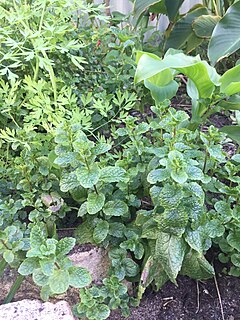
In general use, herbs are plants with savory or aromatic properties that are used for flavoring and garnishing food, for medicinal purposes, or for fragrances; excluding vegetables and other plants consumed for macronutrients. Culinary use typically distinguishes herbs from spices. Herbs generally refers to the leafy green or flowering parts of a plant, while spices are usually dried and produced from other parts of the plant, including seeds, bark, roots and fruits.
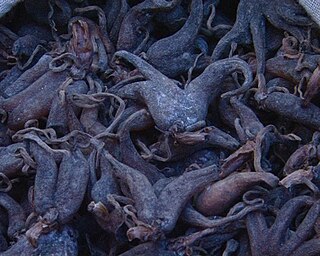
Dactylorhiza hatagirea is a species of orchid generally found growing in the Himalayas, from Pakistan to SE Tibet, at altitudes of 2,800–4,000 metres (9,200–13,100 ft). It is locally called 'salam panja' or 'hatta haddi'. It is called 'panchaule' (पाँचऔंले) in Nepali and Himalayan regions. The name 'panchaule' arises from its root resembling fingers of hand with around 3-5 fingers. It is an erect perennial herb with long flowering stems. The plant is well known for its medicinal value. The root has sweet taste. It is strictly prohibited for collection and sale, but can be found easily around Nepal. It costs around NRs. 10,000-15,000 per kilo as of late 2015.

Chamaecostus cuspidatus, common name fiery costus or spiral flag, is a species of herbaceous plant in the family Costaceae native to eastern Brazil. In India, it is known as insulin plant for its purported anti-diabetic properties.

Sinopodophyllum is an herbaceous perennial plant in the family Berberidaceae, described as a genus in 1979. It includes only one known species, Sinopodophyllum hexandrum, native to Afghanistan, Bhutan, northern India, Kashmir, Nepal, Pakistan, and western China. Common names include Himalayan may apple and Indian may apple.

The Shatavar Vatika Herbal Park, Hisar, named after Shatavar herb, is a 125-acre herbal park for the preservation of several endangered Ayurvedic medicinal herbs, on Dhansu road in the town of Hisar in the Hisar district of Haryana State, India.
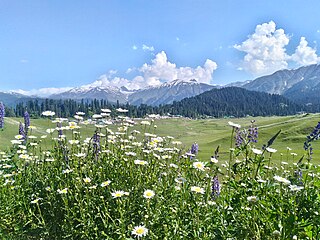
The Gulmarg Wildlife Sanctuary spread over 180 square kilometres (69 sq mi) is a protected area in Baramulla district of Jammu and Kashmir, India. The sanctuary lies on the north-eastern side of the Pir Panjal mountain range and falls under the northwest Biogeographic Zone 2A. It lies 50 kilometres (31 mi) south-west of Srinagar and 26 kilometres (16 mi) from Baramulla. The sanctuary was first declared as a game reserve in 1981 and later upgraded to a sanctuary in 1987.
